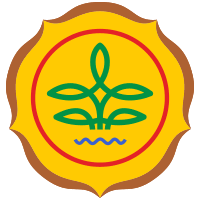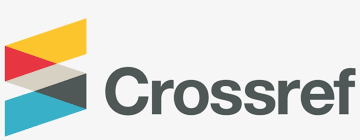AGRONOMIC AND ECONOMIC ANALYSIS OF LOWLAND RICE CULTIVATION USING THE INTEGRATED CROP AND LAND MANAGEMENT APPROACH
Abstract
The research investigated the implementation of Integrated Crops and Land Management (ICLM) model, a holistic farming approach combining various technological elements to enhance productivity. Conducted from April to September 2022 in Bhuana Jaya Village, Tenggarong Seberang Sub-District, Kutai Kartanegara Regency, East Kalimantan Province, on an 8-hectare site, the research focused on key components: utilization of superior rice varieties (Mekongga, Cakrabuana Agritan, and Ciherang Janger), spaced planting methodology (Jajar Legowo), and a balanced fertilization approach encompassing chemical, organic, soil conditioner, and biological fertilizers (50 kg Urea, 300 kg NPK Phonska, 400 kg Petroganik, 10 kg Antazam, and 10 kg Petrobio ha-1, respectively). Liquid Organic Biofertilizer (LOB) were introduced at a rate of 10-20 liters ha-1. The research assessed vital parameters such as plant height, tiller count, panicle length, branch number per panicle, panicle weight, and rice productivity. Statistical analyses included t-tests for plant response and F-tests to evaluate the model's impact on productivity. Economic viability was gauged using the Benefit-Cost (B/C) ratio. The findings revealed substantial productivity gains: 4.13-6.03 t MDG ha-1 (Mekongga), 7.02 t MDG ha-1 (Cakrabuana Agritan), and 7.85 t MDG ha-1 (Ciherang Janger). Moreover, the economic analysis resulted in a favorable ratio of 2.15, indicating the model's financial viability or increased by 69-73%.
Keywords
Full Text:
PDFReferences
Abbas, S. M. (2013). The influence of biostimulants on the growth and on the biochemical composition of Vicia faba CV. Giza 3 beans. Romanian Biotechnological Letters, 18(2), 8061–8068.
Aryawati, S. A. N., Kamandalu, A. A. N. B., Suastika, I. B. K., & Sari, A. R. K. (2020). Agronomy Performance and Increasing of Rice Income by Integrated Crops Management (ICM) Assistance to Support Sustainable Agriculture in Bali Province. Earth and Environmental Science. https://doi.org/10.1088/1755-1315/752/1/012048
BPTP Kalimantan Timur. (2022). Laboratory analysis of liquid organic NPK (in Indonesian).
Center of Soil Research. (1983). Term of Reference Survey Soil Capability (in Indonesian).
Central Bureau Statistics of East Kalimantan. (2022). East Kalimantan Publications in Figures 2021.
Central Bureau Statistics of East Kalimantan. (2023). East Kalimantan Publications in Figures 2022.
Central Bureau Statistics of Indonesia. (2018). SKGB 2018 Konversi Gabah ke Beras.
Ditjen. (2013). Annual Report of the Directorate General of Food Crops in 2012. Ministry of Agriculture.
Ditjen. (2014). Annual Report of the Directorate General of Food Crops in 2013. Kementerian Pertanian.
Fitrah, H. (2019). Reclamation of ex-coal mine land (in Indonesian).
Handayanto, E., Muddarisna, N., & Fiqri, A. (2017). Management of Soil fertility (in Indonesian).
Hartanto, A., Haris, A., & Widodo, D. (2009). Effect calcium, auxin, gibberellin and cytokinin on maize growth and development. Jurnal Kimia Sains Dan Aplikasi, 12 (3), 72–75. https://doi.org/10.14710/jksa.12.3.72-75 (in Indonesian).
Hartono. (2016). SPSS 16.0 : Statistical and research data analysis (2nd ed.) (in Indonesian).
Husen, E., Saraswati, R., & Hastuti, R. D. (2006). Growth-promoting Rhizobacteria Plants. In Organic Fertilizer and Bio Fertilizer. Center for Agricultural Land Resources Research and Development (in Indonesian).
Indonesian Center for Food Crops Research and Development. (2009). Five Years (2005-2009) Food Crop Research and Development. an Agency for Agricultural Research and Development (IAARD).
Kartaatmaja, S., & Fagi, A. M. (2000). Integrated Crop Management, Concepts and Applications. 75–79 (in Indonesian).
Lee, S.-K., Chiang, M.-S., Hseu, Z.-Y., Kuo, C.-H., & Liu, C.-T. (2022). A photosynthetic bacterial inoculant exerts beneficial effects on the yield and quality of tomato and affects bacterial community structure in an organic field. Frontiers in Microbiology. https://doi.org/10.3389/fmicb.2022.959080.
Maheswari, H., Suprihadi, A., Nurhayati, & Abraham, S. (2022). Purification of 5-aminolevulinic acid from strain B10 bacterial culture by ion exchange. NICHE Journal of Tropical Biology, 4 (2), 46–55 (in Indonesian).
Ministry of Agriculture. (2021). Annual Report of the Directorate General Food Crops. In Directorate General of Food Crops.
Mukhlis. (2019). Swamp Soil Microbes and Their Utilization as Biofertilizer and Bioremediator. In Biodiversiti Rawa (pp. 174–197). The Indonesian Agency for Agricultural Research and Development (IAARD) (in Indonesian).
Nurasa, T., & Supriadi, H. (2012). Integrated Crop Management Farmer Field School Program (SL-PTT) Rice: Performance and Policy Anticipation to Support Sustainable Food Self-Sufficiency. 10 No. 4(Agriculture Policy Analysis), 313–329 (in Indonesian).
Nurjaya. (2017). Phosphorus Fixation Problems in Advanced Developmental Soils (Ultisols and Oxisols) and Alternatives to Overcoming them. Prosiding Seminar Nasional Agroinovasi Spesifik Lokasi Untuk Ketahanan Pangan Pada Era Masyarakat Ekonomi ASEAN, 109–117.
Petrokimia. (2019). Fertilizer Products and Dosages (in Indonesian).
Prasetyo, B. H., Suharta, N., H., S., & Hikmatullah, H. (2016). Chemical and Mineralogical Properties of Ultisols of Sasamba Area, East Kalimantan. Indonesian Journal of Agricultural Science, 2(2), 37. https://doi.org/10.21082/ijas.v2n2.2001 (in Indonesian)
Prasetyo, B., & Suriadikarta, D. (2006). Characteristics, Potential, and Management Technology of Ultisol Soils for Dryland Agriculture Development in Indonesia. Jurnal Litbang Pertanian, 25(2), 39–47.
Promol 12 HPAI. (2023). https://www.hpa-network.com/produk/promol12
Purba, T., Situmeang, R., & Rohman, H. F. (2021). Fertilization and Fertilization Technology. Angewandte Chemie International, 6 (11), 951–952.
Radjagukguk, B. (1998). Fundamentals of Soil Chemistry. Yogyakarta Gadjah Mada University Press.
Radjiman. (2020). Introduction to Fertilization. Deepublish.
Rahayu, S. . (2005). The Role of Microorganism in Bioremediation of Heavy Metal Contaminated Soil from Industrial Waste (Review). Buletin Pertanian, 27 (2), 21–29 (in Indonesian).
Rasti, S., & Sumarno. (2008). Utilization of Soil Fertilizing Microbes as a Component of Agricultural Technology. Iptek Tanaman Pangan, Vol 3 No 1, 41–58 (in Indonesian).
Rosadi, A. H. (2015). Balanced Fertilization Policy to Increase National Food Availability. Jurnal Pangan, 24 (1), 1–14 (in Indonesian).
Simanungkalit, R. D. . (2006). Arbuscular Mycorrhizal Fungus. In Organic Fertilizer and Bio Fertilizer. Center for Agricultural Land Resources Research and Development.
Sobat Tani. (2021). Anti-acid Fertilizer Products.
Soekartawi. (2002). Basic principles of agricultural economics: Theory and application.
Soil Research Institute. (2005). Manuals of Soil Chemical, Plant, Water, and Fertilizer Analysis.
Subandiono, R. E., Suryani, E., & Subardja, D. (2014). Soil Properties of Potential Land for Agricultural Development in Jambi Province and Their Management Implications. Jurnal Tanah Dan Iklim, Vol. 38 No, 51–62 (in Indonesian).
Suharta, N., Alkasuma, A., & Suhendra, H. (1994). Soil characteristics and distribution in the Air Kasie II irrigation area, Lubuk Linggau, South Sumatra. In S. Karama (Ed.), Risalah hasil penelitian potensi sumberdaya lahan untuk pengembangan sawah irigasi di Sumatra (pp. 15–30). Center for Soil Research (in Indonesian).
Sumarno, & Suyamto. (1998). Agroecotechnology for Farm Sustainability. Risalah Simposium Ketahanan Pangan (in Indonesian).
Vidali, M. (2001). Pure and Applied Chemistry. International Union of Pure and Applied Chemistry, 73(7), 1163–1172. https://doi.org/10.1351/pac200173071163
Widyabudiningsih, C., & et al. (2021). Preparation and Testing of Liquid Organic Fertilizer from Fruit Peel Waste Fruit Peel Waste with the Addition of EM4 Bioactivator and Variation of Fermentation Time. Ind. J. Chem. Anal., Vol 04, No, 30–39 (in Indonesian).
DOI: http://dx.doi.org/10.30872/jatl.7.1.2024.13802.1-12
Refbacks
- There are currently no refbacks.
Copyright (c) 2024 Jurnal Agroekoteknologi Tropika Lembab







4.jpg)
.jpg)











